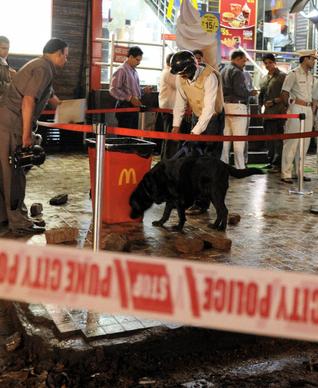
Pune, August 2: Within hours of Sushilkumar Shinde taking over as the country's home minister on Wednesday, coordinated serial terror bomb blasts rocked Pune, a city scarred by the horrible German Bakery attack that killed 17 people two years ago. It marked a shattering of the welcome respite from blasts that the country had enjoyed, and underlined the challenges facing Shinde in his new assignment.
The first bomb went off near the Balgandharv theatre on the busy Jungli Maharaj Road, the venue of an award-giving ceremony that Shinde was scheduled to attend Wednesday evening but cancelled because of his new appointment.
Two people were injured in the four blasts that occurred within an hour of the first one in the heart of Pune, on streets packed with traffic and shoppers. Police said there was almost no damage to property and injuries were few because the bombs used were of very low intensity.
The explosive devices were placed a few metres away from each other on a 700-metre stretch of the road — from Balgandharv chowk to the Garware flyover.
The second device went off in a dustbin outside a McDonald's outlet, the third outside a Dena Bank branch and the fourth close to the Garware flyover, near the eateries at the end of the road. Most of the bombs were placed in cake boxes and the last two devices were attached to bicycles.
The fifth device was defused by the bomb disposal and detection squad (BDDS) outside the Sai Service car showroom.
Although Pune police commissioner Gulabrao Pol initially ruled out involvement of a terror group, sources in New Delhi said such a coordinated attack would not be possible without the planning and logistic resources that only a terror group possesses. Pune has long being a hub for the Indian Mujahideen - the group blamed for the February 13, 2010 attack - and men and material for attacks in Hyderabad and other places have been sourced from Pune. To follow up on the terror angle and the possibility that the blasts were a message that IM was still active in the region, teams of experts from the National Investigation Agency left for Pune from New Delhi and Mumbai.
"All the blasts happened in one locality. It does not seem to be a terrorist attack, rather it seems to be the work of a mischief-maker," police commissioner Pol told TOI. "I don't think terrorists are trying to target Pune. Terrorists use high-intensity bombs. The four low-intensity devices had pencil-cell detonators. The person responsible for the mischief is yet to be identified. Patil is being questioned by senior police officials in hospital," he said
However, the terror angle was also strengthened by theories that the blasts were to avenge the murder of IM commander Qateel Siddiqui at Pune's Yeravada Jail and came hours after a home ministry tribunal headed by a high court judge recommended the extension of a ban on the Students Islamic Movement of India (Simi), a group that's been blamed for radicalizing young Muslims.
One of the injured was identified as Dayanand Bhaurao Patil (34). He suffered minor injuries in the first explosion. Patil was admitted to Sassoon General Hospital. D G Kulkarni, medical superintendent of the hospital, told reporters that Patil, a tailor, was on his way home when he stopped at the Balgandharva chowk to listen to a speech at a rally organized by India Against Corruption activists in support of Team Anna's fast. "Patil said he had kept his bag containing his lunch box and water bottle next to him. While leaving, he said he picked up a wrong bag, which seemed heavier. He said when he opened the bag, it exploded. He suffered minor injuries on the face and stomach," Kulkarni said.
Jangli Maharaj road, which is a major shopping hub and hosts a large number of restaurants, is an arterial link between the Pune-Mumbai highway and the heart of the city. The German Bakery blast of February 13, 2010 happened in the Koregaon Park area, which is around 5 km from J M Road.
Pol denied that the blasts had created panic or even disrupted traffic. "I appeal to people not to fall prey to rumours," he said. Police cordoned off the area where the blasts occurred and cops scoured the area for the possibility of more explosives and also minutely checked the spots where the blasts happened.






Comments
Add new comment